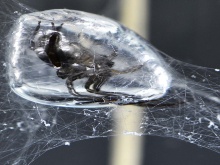Architectural Biomimetics
Evolutionary processes in nature generated manifold solutions towards elementary architectural tasks like materialization of form and adaptation to external stimuli. Similar to the architectural design and production processes, in natural systems, various functional and form generative aspects have to be integrated into a coherent system. Despite these parallels, natural organisms are working radically differently from today's construction and planning practice. While nature evolved highly energy and material efficient solutions, based on fundamental principles like functional integration by geometric and material differentiation, today's construction industry and design processes are mostly based on the standardization of elements and the addition of mono functional subsystems.
Recent developments of computational design and digital fabrication processes have initiated a fundamental paradigm shift from standardized industrial production towards integrated design processes. This seminar will investigate biological role models in two categories of research, with the ultimate goal of transferring useful processes, concepts, and principals into the development of adaptive material systems and building processes.
1. Animal builders and adaptive building processes: In this category the focus lies on structures which are actively built by animals, either by individuals (i.e. spider webs) or by groups of social organisms (i.e. weaver ants). Investigations in this field will analyse how
different sensing strategies are employed to guarantee structural integrity, which structural principles are used for specific tasks and how incremental forming processes can be executed to ensure performance and global stability.
2. Material gradient and functional morphology for compliant mechanism: Research on this topic will investigate how we can reduce complexity of moveable and adaptive structures by employing biological principles for compliant mechanisms. Plant movements such as trap mechanisms in carnivorous plants (i.e. Waterwheel), or reversible elastic deformations offer a variety of soft mechanisms, where movement is obtained by geometric features and distinct distribution of fibrous materials embedded in protein matrices. Thus, it is possible to fine tune mechanical properties within a on material to facilitate functionality.
Evolutionary processes in nature generated manifold solutions towards elementary architectural tasks like materialization of form and adaptation to external stimuli. Similar to the architectural design and production processes, in natural systems, various functional and form generative aspects have to be integrated into a coherent system. Despite these parallels, natural organisms are working radically differently from today's construction and planning practice. While nature evolved highly energy and material efficient solutions, based on fundamental principles like functional integration by geometric and material differentiation, today's construction industry and design processes are mostly based on the standardization of elements and the addition of mono functional subsystems.
Recent developments of computational design and digital fabrication processes have initiated a fundamental paradigm shift from standardized industrial production towards integrated design processes. This seminar will investigate biological role models in two categories of research, with the ultimate goal of transferring useful processes, concepts, and principals into the development of adaptive material systems and building processes.
1. Animal builders and adaptive building processes: In this category the focus lies on structures which are actively built by animals, either by individuals (i.e. spider webs) or by groups of social organisms (i.e. weaver ants). Investigations in this field will analyse how
different sensing strategies are employed to guarantee structural integrity, which structural principles are used for specific tasks and how incremental forming processes can be executed to ensure performance and global stability.
2. Material gradient and functional morphology for compliant mechanism: Research on this topic will investigate how we can reduce complexity of moveable and adaptive structures by employing biological principles for compliant mechanisms. Plant movements such as trap mechanisms in carnivorous plants (i.e. Waterwheel), or reversible elastic deformations offer a variety of soft mechanisms, where movement is obtained by geometric features and distinct distribution of fibrous materials embedded in protein matrices. Thus, it is possible to fine tune mechanical properties within a on material to facilitate functionality.


